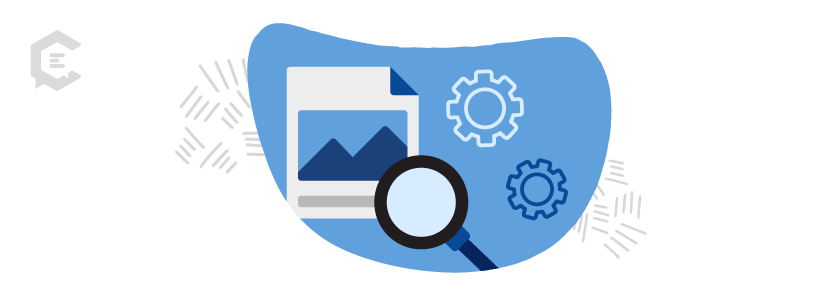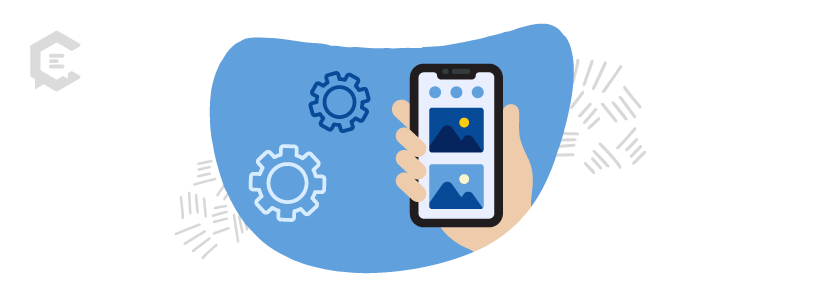“A picture is worth a thousand words” has become a cliche. But it remains true in many instances, including online media. With so much flooding the web, pictures, images, memes, GIFs, and videos can grab attention before a word is ever read.
Social media experts have been emphasizing the importance of visual content for years now. But something often overlooked is how visual media impacts search engine optimization and rankings. Optimizing your visual content for search engines can help your content rank higher and reach more customers.

Why is visual content important for SEO?
In the early days of the internet, you could throw up a blog with little to no formatting and no visual elements and be successful. But nowadays, the competition is a lot more fierce.
Visual content helps your search engine rankings through:
Backlinks and shares
When you have engaging visuals like videos and infographics viewers want to share them. This can get a lot more eyes on your content and give you those natural, quality backlinks that search engines like Google love.
You could even have a graphic that goes viral on social media platforms like Facebook and Pinterest, bringing a huge traffic boost. People love to share visual content.
Keeping visitors engaged
Another thing search engines love is visitors staying on your website longer. This shows you have engaging content that deserves promotion. Visual content helps break up written content and keeps visitors exploring for longer. It has been estimated that content with visuals is viewed over 90% more than text-only content.
Visual content is important to search engines. But here is the thing to remember, search engines like Google cannot read images and visuals like they can your written content. So you have to tell them what is happening.

How to optimize visual content for SEO
Here are some tips to optimize your visual content and make the search engines and visitors happy…
Watch your file sizes
You could have all the information available to Google about an image, but if the file size is so big that it is dragging down the speed of your site, you have a problem. Search engines do not like slow-loading websites because they know it translates to a poor user experience.
To keep your media from slowing down your site, compress images before uploading them or use a compression plugin. If you are creating and sharing videos, you can upload them to a video platform like YouTube first and then share the embed, which will keep the actual file off your site.
Add your sitemaps
A sitemap is an SEO tool that lists your most important pages to make sure search engines can crawl your site and know what it is all about. You can add a general sitemap but you can add video and image sitemaps too.
From Google Developers,
“A video sitemap is a sitemap with additional information about video hosted on your pages. Creating a video sitemap is an excellent way to help Google find and understand the video content on your site, especially content that was recently added or that we might not otherwise discover with our usual crawling mechanisms.”
Optimize with tags and descriptions
Once you have researched appropriate keywords for your content, you will want to do the following:
- Add the keyword as the filename on one of your images.
- Add the keyword in the alt text. Make this descriptive as if you are describing the image to someone who cannot see it.
- Add the keyword into the image title.
- Add the keyword into the caption.
- Describe your image in the metadata.
There are plugins to help with this like Yoast and Rank Math.

Optimize your visual content for social media
To take it a step further, you will also want to add visual content optimized for each of the main social media platforms. Sites like Pinterest, Facebook, and Twitter all have different size recommendations to optimize your graphics for the platform.
Pinterest is one to pay special attention to, as it acts as a search engine for visual content.
Optimize your pins through the same keyword research that you used for your written content and also through Pinterest’s search bar. Optimize your titles and descriptions for all your pins with your keyword, just like you did for the content on your website.
You will want to make sure the graphic itself is clear and relevant. Use easy-to-view images and fonts that will stand out in the feed.
So the next time you create written content, make sure you add a variety of visual elements and optimize them for SEO. You may just see your traffic soar.
Visual content like infographics can help you get more traffic, shares, and backlinks. If you need help writing concise, punchy content for your next infographic, ClearVoice’s expert team of writers can help. Talk to a content specialist today to learn more.



